#Indian Pride Collection
Explore tagged Tumblr posts
Text
Indian Pride Collections Your Ultimate Fashion Sale on Printed T-Shirts!

Welcome to JSR Creations’ exclusive sale on our Indian Pride Collections! We’re excited to offer you a vibrant range of printed T-shirts that embody the spirit and heritage of India. Each design in this collection is a tribute to our rich culture, crafted with passion and precision.
Our fashion sale is the perfect opportunity to refresh your wardrobe with unique, stylish tees that celebrate Indian pride. From eye-catching prints to comfortable fits, our T-shirts are designed to make a statement.
Why Shop Our Indian Pride Collections?
Unique Designs: Each T-shirt features distinct prints that highlight India’s diverse cultural elements.
Quality Materials: Enjoy the blend of comfort and style with our high-quality fabrics.
Unbeatable Prices: Take advantage of our exclusive sale discounts and grab your favorites for less.
Whether you’re looking to express your cultural pride or find the perfect gift, our sale has something for everyone. Don’t miss out on this chance to wear your pride and save big!
Shop now at JSR Creations and let your wardrobe speak volumes about your love for India.
Visit this website for complete details...
JSR Creations
#mensfashion#menswear#outfit#styleblogger#t shirts printing#tee shirt#tshirtdesign#outfit inspiration#model off duty#t shirt design#Indian Pride Collection
0 notes
Text

ID: A flag with eight horizontal stripes, all the same size. The colors are, from top to bottom, maroon, dark burnt orange, washed-out orange, washed-out yellow-gold, white, sky blue, cerulean, and dark denim. END ID
Indiansica: A gender related to the Anthrax song Indians
The colors come from my associations with the song
#Indiansica#Anthrax Indians Collection#Anthraxgender#Musicagender#liom gender#mogai coining#liom#xenogender#liom coining#xenogender pride#coining post#gender coining#xenogender coining#liom term
6 notes
·
View notes
Text
harry didn’t grow up with stories of james potter, the indian boy who ran through hogwarts, loud and proud and full of life. he didn’t know that his father’s voice would fill the great hall with laughter, or that james would argue passionately in defense of his culture, unafraid to bring the fire of his heritage into every room he walked into.
but as harry gets older, he starts piecing things together, collecting fragments of a man who left echoes behind him. he learns from professors that james would use his wand to create vibrant garlands during festivals, brightening the gryffindor common room with colors his classmates had never seen. he’d coax sirius into trying spicy food they’d never even heard of, laughing as they both coughed and spluttered but insisted on more. and when they celebrated deepavali, james would tell them, grinning with pride, about how it wasn’t just a festival of lights, but a reminder of resilience, of the light within that never dims. he'd shown that same resilience during the war.
harry hears whispers from people who knew his father—the way james insisted on using tamil compliments because they “sounded much better,” the way he would answer teachers in tamil just to remind everyone where he came from. the way he’d refer to remus as “nanbaa” (friend), that special affection saved for the people who shared your burdens. how he called lily his “thangam” (gold) because of the colour her hair shone in the sunlight.
and slowly, harry begins to reclaim pieces of his father. he learns how to wrap a veshti, stubbornly practicing until he gets it right, because he knows it’s something james would’ve worn proudly. he finds comfort in the smell of his dad’s favorite spices, brings them with him to work as his own quiet rebellion, and teaches ron and hermione how to roll up chapatis late at night in grimmauld place.
#desi!james potter#desi harry#indian harry potter#tamil#poc harry potter#mod des#hp#Harry Potter#South Indian Harry Potter#desi harry potter#Tamil Harry Potter#marauders#wolfstar#remus lupin#james and sirius#marauders headcanon#sirius orion black#harry potter#marauders map#sirius being sirius#the marauders#james & peter & remus & sirius#peter pettigrew#james fleamont potter#desi james potter#james potter#cherry<3#writing#ao3#headcanon
244 notes
·
View notes
Note
Loved all your info about Empyrean with my last ask and left comments/reblog to it, and so sorry to spam your asks especially when you’re still working on this idea, but I’m just curious and want to hear whatever ramblings you’d like to share!
You mentioned Heartslabyul being inspired by Europe with a dash of volcanos via borders and I’m sure there’s going to be lots of references to the regions of origin for the fairytales/Disney movies for each. But are there other places of the world you’re drawing inspiration from, whether in real life or from Genshin too?
You’ve given teasers about Leona and Idia, along with the original premise post for a few of the other archons, are there any other backstories you’ve been developing for the archons or even the other characters?
Again, sorry to spam your asks but the more I look into Genshin, the more I’m excited by Empyrean and wishing you all the best in writing~!
So if y'all recall, my biggest qualm with Genshin Impact was the amalgamation of cultures and cultures as costume. I am NOT trying to do that here. However, here's the problem when it comes to implementing the twst x genshin au: a majority of the stories are based in Europe or have European origins. So that means that most of the world, if we go by that logic, would be European, which doesn't sit right with me.
So for story's sake, I think I'll imply in the story that the seven nations are the ones of the known world, and the most recognized due to their archon's power. I've considered maybe changing the setting of a nation, but that doesn't exactly sit right with me either. So that's why I stated here and like I said, it will be implied in the story, that there is another part of the world not even really known. That being said, I probably won't lean too heavily into the cultural aspect of the story. However, there will be mentions here and there. Keep in mind though, I belong to none of these cultures, so I'll try to research to the best of my ability but it's also why, like I just said, I don't want to heavily into the cultural aspect of the story, because by no means do I want to get something wrong and offend anyone.
Here's my thought process for the inspiration of each. Keep in mind, this is still very much a work in progress.
Heartslabyul: British Isles
If you thought this was gonna be any other place, then what the hell are you thinking? Riddle definitely has a British accent. The tea, the tarts, all that stuff? Very British, if you ask me. Of course there's the fact that the original author of Alice's Adventures in Wonderland is from Britain.
Savanaclaw: East Africa
After bit of research, I found several things. Such as the fact that many of the names from The Lion King movie are based off the Swahili language. Zulu is apparently also spoken in the opening song, The Circle of Life. Additionally, the Pride Lands are said to be set in either Tanzania or Kenya.
Octavinelle: Scandinavia(?)
I know a lot of people like to debate where The Little Mermaid takes place, but I'm basing this on the origins of the author, as he is Danish. Also, if you recall, I believe there's in game dialogue where one of the Octavinelle characters mentions how ice often makes it difficult for them to return home, thus suggesting that their homeland is very cold. Originally I did want to add a tropical location, but this complicates things.
Scarabia: Arabian Peninsula(?)
Yes, yes, there's the fact that the movie of Aladdin takes inspiration from Indian and other Southeast Asian cultures, but from what I've seen, the story seems to mainly derive from Arabic cultures. Aside for the fact that the story of Aladdin is said to come from the Islamic Golden Age and is from a collection of Middle Eastern folktales. If you research names like Kalim or Jamil, they do have Arabic origins.
Pomefiore: Central/Eastern Europe(?)
We all know the Brothers Grimm, yes? Authors of many fairytales, one of which being Snow White. Well, they're German. And, I mean, the archon is going to be Vil SCHOENHEIT, if that's not German sounding last name, then I dunno what is. Why did I include Eastern Europe? Because I personally HC a lot of the characters with accents and the accent I imagine Epel with is some type of Slavic. God, I love creative freedom.
Ignihyde: Greece
This one isn't even a debate. I don't gotta say why.
Diasomnia: Western Europe(?)
It is said that one of the earliest records of Sleeping Beauty was in a French book. If we look at some of the inspiration from the movie, it's said to take place in a French medieval kingdom. So yeah, it just made sense in my mind.
69 notes
·
View notes
Text

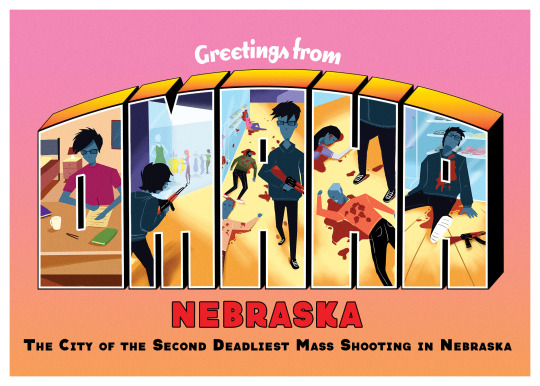







vimeo
“Because the US government was not acting on mass shootings, we directly attacked a trait Americans are most known for: their pride in their country. Change the Ref created the Shamecards, a postcard collection designed to demand gun law reform from Congress. Subverting the traditional greeting cards that depict each city’s landmarks, ours show what cities are becoming known for.”
shamecards.org
There is 54 cards total representing:
Annapolis — Maryland: Capital Gazette Shooting
Atlanta — Georgia: Day Trading Firm Shootings
Benton — Kentucky: Marshall County High School Shooting
Bethel — Alaska: Regional High School Shooting
Binghamton — New York: Binghamton Shooting
Blacksburg — Virginia: Virginia Tech Massacre
Camden – New Jersey: Walk of Death Massacre
Charleston — South Carolina: Charleston Church Shooting
Charlotte — North Carolina: 2019 University Shooting
Cheyenne — Wyoming: Senior Home Shooting
Chicago — Illinois: Medical Center Shooting
Clovis — New Mexico: Clovis Library Shooting
Columbine — Colorado: Columbine
Dayton — Ohio: Dayton Shooting
Edmond — Oklahoma: Post Office Shooting
El Paso — Texas: El Paso Shooting
Ennis — Montana: Madison County Shooting
Essex Junction — Vermont: Essex Elementary School Shooting
Geneva — Alabama: Geneva County Massacre.
Grand Forks — North Dakota: Grand Forks Shooting
Hesston — Kansas: Hesston Shooting
Honolulu — Hawaii: First Hawaiian Mass Shooting
Huntington — West Virginia: New Year's Eve Shooting
Indianapolis — Indiana: Hamilton Avenue Murders
Iowa City — Iowa: University Shooting
Jonesboro — Arkansas: Middle School Massacre
Kalamazoo — Michigan: Kalamazoo Shooting
Lafayette — Louisana: Lafayette Shooting
Las Vegas — Nevada: Las Vegas Strip Shooting
Madison — Maine: Madison Rampage
Meridian — Mississippi: Meridian Company Shooting
Moscow — Idaho: Moscow Rampage
Nashville — Tennessee: Nashville Waffle House shooting
Newtown — Connecticut: Sandy Hook Elementary School Shooting
Omaha — Nebraska: Westroads Mall shooting
Orlando — Florida: Pulse Nightclub Shooting
Parkland — Florida: Parkland School Shooting
Pelham — New Hampshire: Wedding Shooting
Pittsburgh — Pennsylvania: Pittsburgh Synagogue Shooting
Prices Corner — Delaware: Delaware Shooting
Red Lake — Minnesota: Indian Reservation Shooting
Roseburg — Oregon: Umpqua Community Collage Shooting
Salt Lake City — Utah: Salt Lake City Mall Shooting
San Diego — California: San Ysidro Massacre
Santa Fe — Texas: Santa Fe School Shooting
Schofield — Wisconsin: Marathon County Shooting
Seattle — Washington: Capitol Hill Massacre
Sisseton — South Dakota: Sisseton Massacre
St. Louis — Missouri: Power Plant Shooting
Sutherland Springs — Texas: Sutherland Springs Church Shooting
Tucson — Arizona: Tocson Shooting
Wakefield — Massachusetts: Tech Company Massacre
Washington — D.C.: Navy Yard Shooting
Westerly — Rhode Island: Assisted-Living Complex Rampage
64 notes
·
View notes
Text
The cis theory of gender also fails to take on the psychology of oppression. It erroneously assumes that any person who does not want to transition is perfectly happy with their assigned gender at birth. Those humans who fail to stage a very specific kind of public performance - the act of transitioning - are assumed to affirmatively embrace the gender assigned to them at birth.
Yet gender's imprint on the identities of female humans cannot be measured by their apparent assimilation to being "girls" and "women." Women's internalization of gender identity and gender roles has been analyzed endlessly by feminist and political theorists of all kinds. Over a century and a half ago John Stuart Mill (in collaboration with his wife Harriet Taylor Mill, whose intellectual contributions were subsumed under her husband's name precisely because of gender roles) put it plainly in "The Subjection of Women":
All causes, social and natural, combine to make it unlikely that women should be collectively rebellious to the power of men. . . . All men, except the most brutish, desire to have, in the woman most nearly connected with them, not a forced slave but a willing one, not a slave merely, but a favorite. They have therefore put everything in practice to enslave their minds.
This passage highlights the importance of psychological control as a tool of domination. It is undeniable that some women are willing to participate in the structures of our own oppres-sion. Radical feminist Andrea Dworkin's Right-Wing Women is all about this." Liberal feminist Betty Friedan's The Feminine Mystique describes the quiet desperation of women suffering under the crushing weight their own conformity to women's sex-specific social positions as wives and mothers. These very different but very classic feminist texts, along with many oth-mers, have helped women understand how identification with gender is externally constructed; how we relate to the sex-based social roles expected of us; and why we might come to embrace practices or behaviors that ultimately serve to harm us.
Adopting the values of the oppressor is a well-documented coping skill of people who are debased and essentialized. Feminists know that women are not unique in internalizing their own subjugation:
Coerced assimilation is in fact one of the policies available to an oppressing group in its effort to reduce and/or annihilate another group. This tactic is used by the U.S. government, for instance, on the American Indians.
Similarly, women have been subtly and not-so-subtly groomed to take joy or pride in the superficial social rewards of gender conformity. The target characteristics of the female gender role—to be passive, people pleasing, and self-blaming—increase the likelihood of eventual assimilation. Women who did not internally identify with femininity but who were willing to do whatever it took to fit in, to suffer in silence, to pretend forever; of women who grudgingly resigned themselves to their social role under threat of violence or social ostracization; these women are not part of the cis/trans theory of gender identification.
-Elizabeth Hungerford, “Female Erasure, Reverse Sexism, and the Cisgender Theory of Privilege” in Female Erasure
#Elizabeth Hungerford#female socialization#female oppression#transgender theory#radical feminist theory#psychology of oppression
55 notes
·
View notes
Text

My Bengali trans queer debut poetry collection There Used to Be a Lake Here Once was mentioned for the 2024 Pride Collection of Writers Workshop, an Indian independent publishing house. In this list, my book is featured alongside some of my greatest poetry inspirations– the works of Suniti Namjoshi, Agha Shahid Ali, Hoshang Merchant.
If you want to support Indian queer voices, small literary press, trans poetry or just read about growing up in Kolkata as a queer kid in the 2000s, you can buy my book here.
#mimiwrites#lake tag#pride month#pride 2024#lgbtq authors#queer books#lgbtq#desi pride#queer desi#desiblr#bengali#desi academia#trans authors#trans poetry#trans#bisexual#sapphic books#bisexual books#sapphic#indian literature#literature#poetry#poets of tumblr#my writing#heh
118 notes
·
View notes
Text
Boita Bandana, a cultural tribute to ancient maritime activities

People in Odisha celebrate Boita Bandana, a boat festival marking the region's maritime glory. This annual observance occurs on Kartik Purnima, the full moon day in the holy month of Kartik. Boita Bandana is a cultural tribute to Odisha’s ancient maritime activities and trade relations with Southeast Asian countries.
Symbolic Act of Floating Boats:

The most important ritual of Boita Bandana is floating little hand-made boats. They are usually made of plantain or banana stems and other similar natural and traditional materials. Boats are laden with various offerings such as flowers, coins, ‘Kaudis’ or cowries, ‘Pana’ or betel leaves, ‘Guā’ or betel nuts, and a lighted lamp. This symbolic act pays homage to Odisha’s rich maritime history and the courageous sailors who engaged in trade with Southeast Asian nations. The festival serves as a cultural bridge connecting the present generation with the seafaring legacy of their ancestors.
Remembering the Sadhabas:
Boita Bandana echoes the collective consciousness & memories of the past. It commemorates the legacies of the Kalinga Sadhabas – the maritime merchants & seafarers. The origins of this festival descend from an ancient maritime tradition of merchant trade and voyages across the ocean to different regions of Asia, which was well developed in this region known in ancient times as Kalinga. This ancient maritime tradition is preserved through this festival which celebrates the voyages of their ancestors, to Southeast Asian countries, which include mainly present-day Bali, Java, Sumatra, and Borneo in Indonesia, Malaysia, Sri Lanka, Thailand, Cambodia, and all the way to Champa region in Vietnam. Local traditions ascribe the origins of the ritual tradition to around the 3rd century BC as Kalinga was a well-known powerful maritime power with strong trading links across the oceans, especially during the reign of the Maurya empire whose rulers coveted the region for its influence.
Kartika Purnima was considered auspicious for them to begin their voyage. It was during this time of the month as well when the Northeast monsoon winds started blowing from November, which was favorable for the merchant mariners as the winds would guide the sails of their boats across the ocean leading them southwards towards Sri Lanka. Thereafter using the ocean currents to cross the Indian Ocean to reach Southeast Asia where they would carry on sailing across different regions for trade. After trading the ships would take the ocean countercurrent to get back to Sri Lanka in time to take advantage of the Southwest monsoon around May and return home. Hence the families of the traveling sailors used to perform rituals on the day of Kartik Purnima for their safe journey and return, which henceforth became the tradition of Boita Bandana (Worship of the Boats).
Boita Bandana and Jagannath Culture:
At Sri Mandira (Jagannath Puri), the deities wear a variety of attires, or ‘besa’, throughout the year. During the holy month of Kartika, they receive special ‘besa’ outfits. In years when the Kartika month includes six days of ‘Panchaka’ instead of the usual five, the deities wear the rare and unique ‘Nagarjuna Besa’. In this special attire, the deities are dressed like ‘Nagarjuna’, a revered figure. This unique ‘besa’ is a significant part of the Kartika Purnima celebrations in Puri. And, Boita Bandana is every year meant to be celebrated in the early morning of Kartik Purnima.
Boita Bandana serves as a vibrant reminder of Odisha’s historical ties with other maritime civilizations and instills a sense of cultural pride among the people.
Information from different sources.
38 notes
·
View notes
Text
Opening and reviewing my first Australian Girl doll

She spent more than a month in a box, making her way halfway across the world to her new home, and now here she is! I'm so relieved that she arrived safely. It was the longest I've ever had to wait for a doll, and through much of her journey I didn't know where she was or when she would be here.
I don't want to drop too big of a spoiler, but listen to this........ she was so worth the wait, and the money. This doll instantly won my heart with how exquisite she is in every way.
Australian Girl dolls were specially made for Australian children, by Helen Schofield, a grandmother who loved dolls. She created the brand when she couldn't find an age appropriate doll that was locally available or good quality. So she created these dolls to help children feel pride in Australian culture, while teaching them about friendship and empathy. There are five girls to befriend--Amy, Jasmine, Emily, Bronte, and Matilda, each representing a different region of the country, ethnicity, and lifestyle.
The company itself has quite high standards. They strive to reduce waste in their product packaging, and they use a factory in China that treats its workers humanely and does not use child labor.

If you've been around my blog for a while, you know how much I love collecting diverse brands and types of play dolls, especially international dolls. Also, this one will be extra special because I actually have an Australian grandmother--she's also a doll collector, and I'm looking forward to showing her my new doll the next time I see her.
After the cut, I'll show you who she is, and talk about why I chose her. I'll compare her with similar-sized dolls as well, and have her do some dressing up.
Before we get to the unboxing, let's check out the little goodies included with my doll.

First is a little pamphlet explaining why the dolls are special, but also represent real girls growing up in Australia.
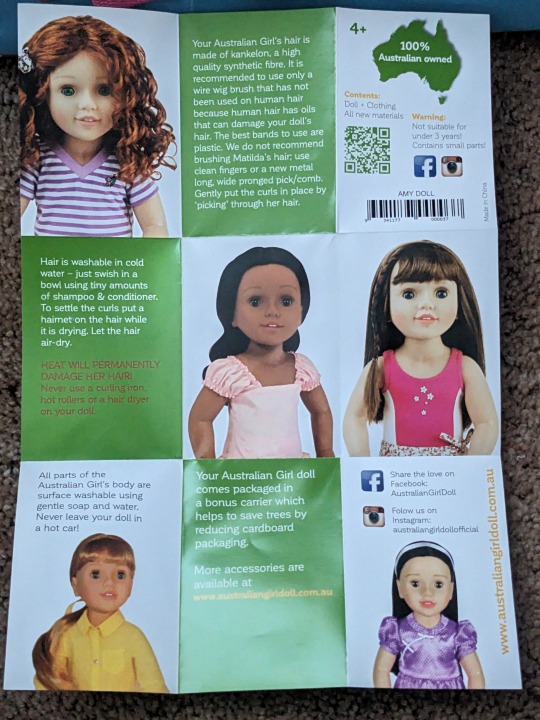
There's another pamphlet about how to care for your doll.

All of the dolls come with a fun freebie: this cute pair of thongs.

Another freebie (a $30 AUD value) is this very sturdy doll carrier with pockets for accessories.

I also bought a pair of sneakers for my new girl. I figured her feet would be a bit larger than my other dolls, and these are cute, so she now has three pairs of shoes to wear.
Anyway. Enough of the small stuff. Let's let her out of the box.

It's Amy from Adelaide!
I chose Amy after three entire years of being indecisive and going back and forth on exactly which Australian Girl I wanted. They're all equally adorable, so I picked Amy because her personality seems very sweet, and I love that she has mixed heritage. According to the Austrlaian Girl dolls website, Amy's family tree is a mix of Aboriginal and Dutch on her mother's side, and English and Indian/Fijian on her father's side. Very representative of modern Australia!
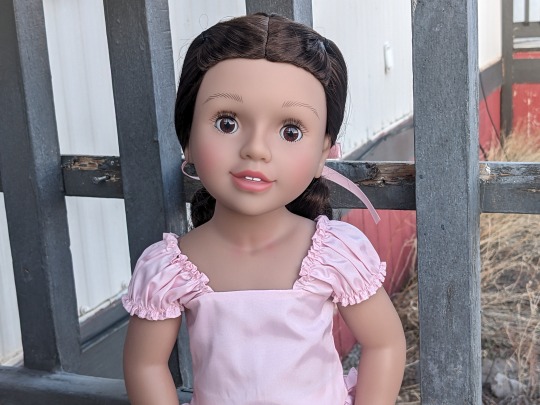
I have no regrets. She is perfect!!! Just the most charming little angel. I am officially WOWED.

I'm seriously impressed at the superior quality of her construction. I understand why she was priced a bit higher than similar dolls. She is, from head to toe, beautifully made, with so many sweet details. Her dress and shoes are also impeccably made and feel very durable.

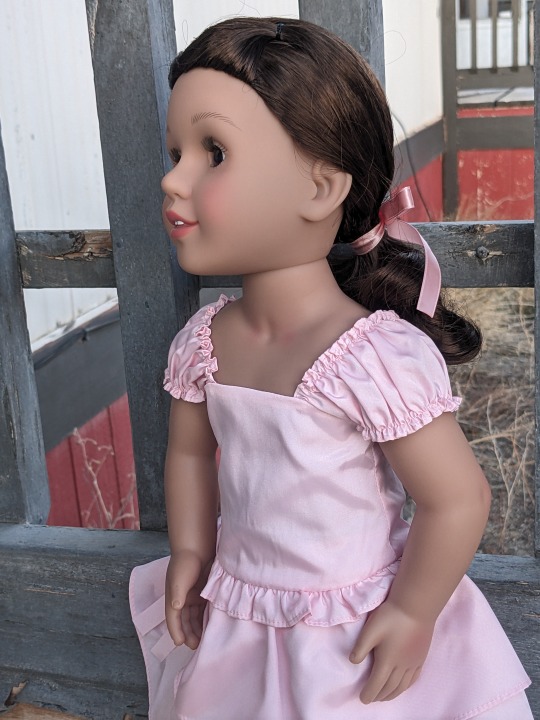
Her hair is flawless. It's a Kanekalon wig with loose curls, in a gorgeous shade of brown. Her eyes open and close. She has both painted and attached eyelashes.

She has a gap between her big toe and the next toe, so she can wear her sandals and thongs.

Her elbows are dimpled and she has subtle blush color on parts of her skin, including elbows and hands.
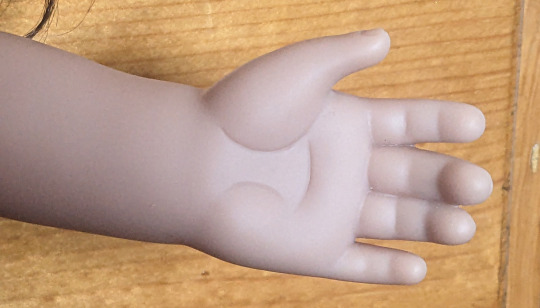
She has a crease across her palm.

She has articulation at her shoulders, hips, and neck. Her limbs, head, and shoulders are vinyl, and she has a huggable soft tummy. I don't really have a strong preference for either cloth torsos, vinyl torsos, or half and half like Amy. They all have pros and cons. This specific construction is nice in that she can wear low-neckline clothes without showing a cloth body, but it does make her harder to repair in case she has to be fixed.
I have a pretty good idea of what she'll be wearing when she's ready to change out of her pink party dress.






The first photo shows her in a dress I made. The second is a Maplelea dress and hat. The rest are all American Girl brand clothing, except for the shoes. Amy can comfortably wear most stretchy clothes by AG and similar brands like Our Generation, but her feet absolutely will not fit AG, OG, or Maplelea shoes.

The exception to the clothes is some of the tighter pieces. This AG shirt did not fit well. Amy's shoulders are a bit more broad than smaller dolls, and so without some extra give this is too tight.
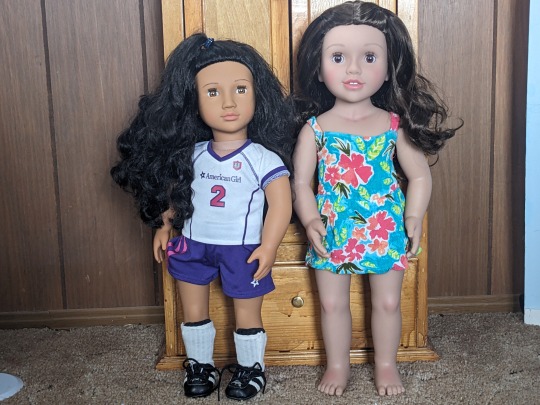
Amy is 20 inches/51 centimeters tall. Here she is next to my Our Generation doll Jordana. I'm using an OG doll because they're actually available locally in Australia. Whereas American Girl dolls, which I usually use when I compare brands, have to make an overseas journey. So it's only fair that I consider any Australians reading this now who are wondering how Amy compares.

Amy is tall, but not the tallest doll in the family! Here she is next to Fernanda, my Karito Kids doll, who is about an inch taller although slimmer. Karito Kids dolls are in fact just slightly skinnier than American Girl dolls, so they have a much easier time sharing clothes.
In conclusion, I highly highly recommend this doll. She's absolutely sublime! I'm so thrilled to have her here, and I'm looking forward to having lots of adventures with her.
Obviously I'm far from Australia, but my Amy will still live her life as if she were in a suburb outside of the city of Adelaide. I've been looking at pictures of the geography of the state of South Australia, and there are some places in the mountainous parts that look pretty similar to the desert southwest where I live. So Amy will have no idea she's actually in the USA. Don't tell her the truth!
57 notes
·
View notes
Text
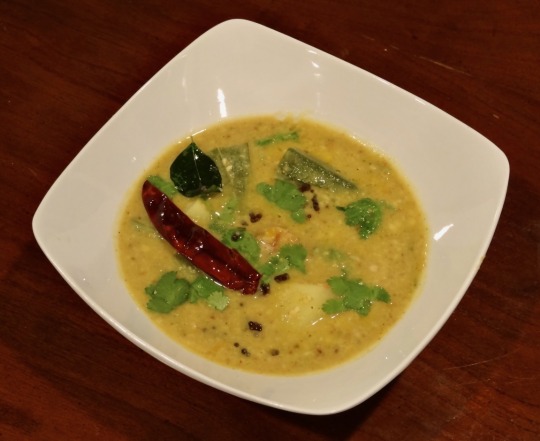
[ID: A bowl of a bright yellow stew topped with cilantro, mustard seed, chili, and curry leaf. End ID]
ಉಡುಪಿ ಸಾಂಬಾರ್ / Udupi sambar
A sambar is a lentil-and-vegetable stew distinguished by the use of a particular spice blend (Hindi: सांबर मसाला "sāmbār masālā," "sambar spice"; Kannada: ಸಾಂಬಾರ್ ಪುಡಿ "sāmbār puḍi," "sambar powder"). Sambars are a staple of South Indian and Sri Lankan cooking, sometimes made in households for multiple meals a week. The word "sambar" can be traced back to the Sanskrit सम्भार "sambhārá," "collection of things required for a particular purpose”; “spices."
The lentil used in sambar dishes is usually tur dal (split pigeon peas), though arhar dal, tuvur dal, or even blends containing masur or mung dal may be used, depending on the cook or the region. Vegetables also vary between combinations of okra, potato, ash gourd (petha), bottle gourd (doodhi / lauki), drumstick (saijan ki phalli), beetroot, tomato, carrot, pumpkin, brinjal, and pearl onions, among others. The sambar masala fries chilis, curry leaves, dal, and various spices including cumin, coriander, and fenugreek, then grinds them into a spicy, earthy, fragrant blend.
This recipe makes a sambar in the style of ಉಡುಪಿ (Udupi) cuisine—a subdivision of the cuisine of the ತುಳುವ (Tuluva) people localised in the Udupi District of Karnataka, a southeastern coastal state of India. (Tuluva cuisine is also commonly found in Dakshina Kannada, Karnataka, and Kasaragod, Kerala). In the Udupi region, sambar may be known as "ಕೊಡೆಲ್" "kodhel"; perhaps related to "ಕಡಲೆ" "kadhale" "Bengal gram"; or "ಹುಲಿ" "huḷi"; "tartness." Udupi huli has coconut oil and jaggery as its primary distinguishing features: the jaggery's deep sweetness and the earthy pungency of unrefined coconut oil combine with the spice of the chilis and the sour fruitiness of the tamarind to create a complex, flavorful, well-balanced dish.
Udupi huli may be further divided into a few major types. ಮಸಾಲೆ ಹುಳಿ ("masāla huḷi") contains shredded coconut and vegetables; ಬೋಳು ಹುಳಿ ("bolu huḷi") contains vegetables, but omits the coconut.
Hotel-style masala huli recipes typically add a lot of jaggery to produce a distinct sweetness; cut back on the amount of coconut included; and contain onion and garlic. The other main type of masala huli—“temple style”—is sattvic (from Sanskrit "सत्त्व" "sattva": "goodness," "essence," "existence"), which in this context means that onions and garlic are excluded.
A sattvic diet in Hinduism centres around the concept of maintaining sattva by eating only pure and mild (sattvic) foods, and omitting tamasic (“dark,” "inert," "destructive"; from Sanskrit तमस् "tamas") and rajasic ("exciting," "passionate," from Sanskrit रजस् "rajas") ones. The concepts of sattva, tamas, and rajas (the गुण "guṇa" system) are central to the construction of caste: the degree to which each person innately inherits each quality supposedly determines their possession of characteristics including honesty, intelligence, and goodness (sattva), stupidity and lack of creativity (tamas), and passion and pridefulness (rajas); the possession of these characteristics in turn determines their rightful place in a professional and social hierarchy. The association of certain foods with certain qualities thus links diet to caste: a distinction in diet is one of the methods by which those belonging to upper castes maintain and police caste boundaries.
This recipe makes enough pudi for one pot of sambar. Traditionally, sambar pudi is created fresh each time the dish is made, but many households make large batches and store them. In this case, omit the coconut; or, use dried coconut and store the masala in the refrigerator.
Recipe under the cut!
Patreon | Paypal | Venmo
Ingredients:
Serves 4-6.
For the sambar:
2 cups chopped vegetables
1 red onion, sliced*
1 cup (200g) yellow split pigeon peas / tur dal / ತೂರ್ ದಾಲ್ (ಹಳದಿ ಸ್ಪ್ಲಿಟ್ ಪಾರಿವಾಳದ ಬಟಾಣಿ)
4 cups (1 litre) water, or as needed
1/4 tsp ground turmeric / haldi / ಅರಿಶಿನ
2 tsp table salt
2 tsp jaggery / gur / ಬೆಲ್ಲ*
1/4 cup (60mL) tamarind pulp (from 1 Tbsp dried tamarind / imlie / ಹುಣಸೆಹಣ್ಣು)
2 tsp unrefined coconut oil / nariyal ka tel / ತೆಂಗಿನ ಎಣ್ಣೆ
Ingredient list format is English / Hindi (Latin transcription) / Kannada. The Hindi is provided for convenience while shopping.
Udupi sambar usually uses any of: gourd, brinjal (Indian eggplant), pumpkin, dumstick (saijan ki phalli), and okra. Pearl onion is not usually used in this region, but you can add whatever you want, according to taste.
*For a hotel-style sambar, include the onion; increase the jaggery to 2 Tbsp.
For the spice paste / sambar masala / ಸಾಂಬಾರ್ ಪುಡಿ ("sambar pudi"):
1/2 Tbsp split Bengal gram / chana dal / ಹಳದಿ ಸ್ಪ್ಲಿಟ್ ಗ್ರಾಂ
2 tsp split black gram / urad dal chilka / ಸ್ಪ್ಲಿಟ್ ಬ್ಲ್ಯಾಕ್ ಗ್ರಾಂ
2 tsp coriander seeds / dhaniya / ಕೊತ್ತಂಬರಿ ಬೀಜದ
1/2 tsp fenugreek seeds / methi / ಮೆಂತ್ಯ
1 tsp cumin seeds / jeera / ಜೀರಿಗೆ
1 tsp ground turmeric
5-6 curry leaves / kari pati / ಕರಿಬೇವು
3-4 Byadagi or other dried red chilis / byadagi mirch / ಬ್ಯಾಡಗಿ ಮೆಣಸಿನಕಾಯಿ
4 cloves garlic, skins on*
Large pinch asafoetida / hing / ಇಂಗು
1 cup (100g) fresh coconut (about one coconut)*
1/2 cup (120mL) water
While the ratio of ingredients in Udupi sambar pudi vary slightly, the ingredients themselves are almost always consistent.
*For a hotel-style sambar, include the garlic, and decrease the coconut in the sambar masala to 1/4 or 1/2 cup (25-50g).
The grams and pulses in this pudi have many different names. You can find them in a halal or South Asian grocery store; look on the bag for the Hindi names (since they have been transcribed into Latin, the spelling may vary from what you see here).
The urad dal you find may be husked, and thus yellow instead of black; these will work just as well.
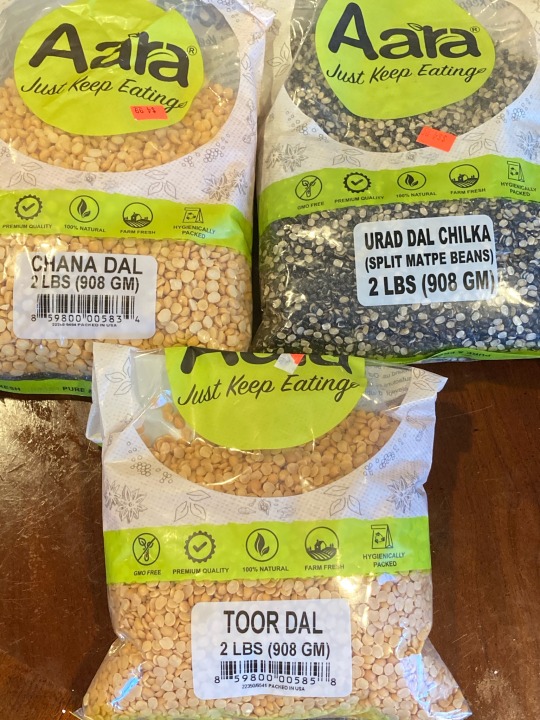
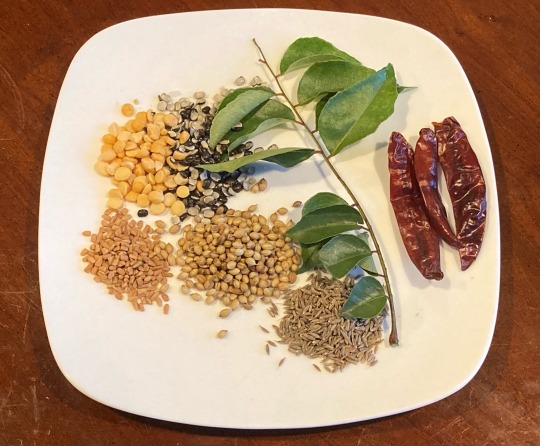
For the tempering / tadka / ಹದಗೊಳಿಸುವ:
2 Tbsp unrefined coconut oil
2 red chilis
8 curry leaves
1 tsp brown mustard seeds / rai / ಸಾಸಿವೆ ಬೀಜಗಳು
Recipes from north Karnataka may add cumin and whole, unpeeled garlic cloves to the tempering.
Instructions:
For the sambar pudi:
1. Break open the coconut and remove and shread its flesh.
If using a whole dried coconut, break into the shell with the wrong side of a hammer and pry open. Break into a few smaller pieces and peel with a vegetable peeler until the skin is removed from the white flesh, wearing something to protect your hand. Soak in warm water for several minutes to soften, and then grate or food process.

2. Heat 2 Tbsp of coconut oil in a skillet on medium-low. Add asafoetida and fry for 30 seconds, until no longer raw-smelling. Add dal and fry, stirring often, for 30 seconds until golden brown; add coriander, mustard, fenugreek, and cumin seeds and fry until fragrant.
3. Add curry leaves and fry until wilted, then add garlic and dried chilis and fry another 30 seconds to a minute, until fragrant.
4. Add coconut and fry, stirring often, for another few minutes until a shade darker. Add turmeric and stir.
5. Grind all ingredients into a paste in a mortar and pestle, then mix in about 1/2 cup water to loosen (if using dried coconut, you may need more water).
Or, put all ingredients along with 1/2 cup water into a blender or food processor and process until a relatively smooth paste forms.
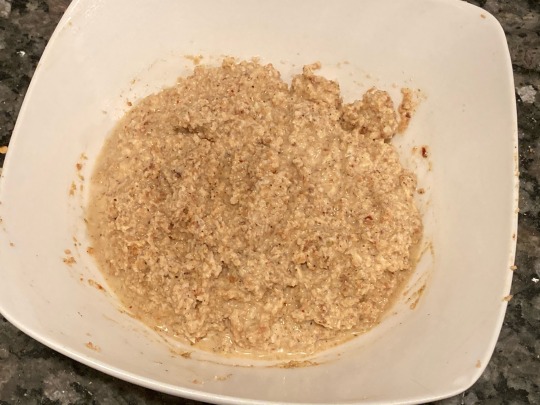
For the sambar:
1. Wash tur dal to remove excess starch. Simmer dal with 2 cups water, 1/4 tsp ground turmeric, and 1 tsp coconut oil for about 30 minutes until very tender. Mash until relatively smooth with a wooden spoon or bean masher, or process briefly with an immersion blender.
You may soak the dal in water after rinsing them to reduce the cooking time, but it is not necessary.
2. Meanwhile, make the tamarind paste. Soak 1 Tbsp tamarind dried pulp in 1/4 cup hot water for 20-30 minutes. Squeeze the tamarind into the water to extract the pulp. Discard the tamarind seeds and husk. Optionally, depending on your preferred texture, push the mixture through a metal sieve.
3. Prepare vegetables. Slice the onion; remove ends of okra and drumsticks and cut into 2-inch pieces; quarter tomatoes; quarter brinjal; peel pumpkin and cut into cubes; peel and cube potatoes.
4. If using onion, add a teaspoon of coconut oil to a large pot and fry until translucent.
5. In the same pot, boil vegetables in just enough water to cover, along with a pinch of salt, until they are beginning to soften.
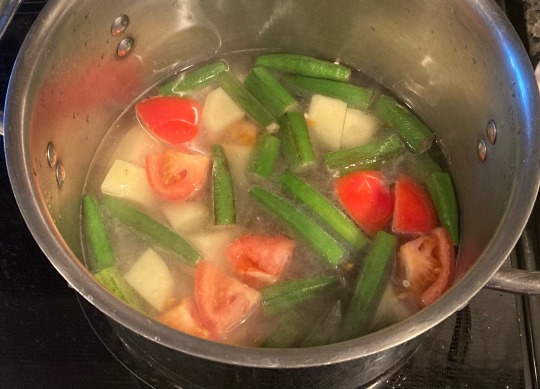
Some recipes call for the vegetables to be boiled, and others call for them to be steamed. I prefer boiling, since it produces a nice savory broth.
6. Mix vegetables, dal, tamarind, jaggery, sambar pudi, and salt to taste and simmer 5-10 minutes to allow flavors to combine and vegetables to cook under tender. Add water as needed. Remove from heat and stir in cilantro. Taste and adjust salt.
The final sambar should be pourable, like a thick soup—Karnataka sambar is typically thinner in consistency than Tamil Nadu versions.
For the tadka:
1. Heat coconut oil in a small skillet on medium heat. Add tempering ingredients and fry, stirring often, until chilis and curry leaves are a couple shades darker and the mixture is fragrant.
2. Pour the oil and tempering ingredients into the sambar and stir in. If you like, retain some of the tadka as a garnish to serve.
3. Serve warm, in individual bowls, alongside long-grain white rice. To eat drumsticks, scoop the center out and eat it; the tough outer rind is left.
If you intend to save some sambar, it's a good idea to make just enough tadka for what you plan to eat that day, and then make fresh tadka to pour over the reheated leftovers.
112 notes
·
View notes
Note
its so comforting to see someone unbashedly love their country and culture. the way u write and speak of it its so refreshing to me. im from india and well, the state of our country isnt good our fascist leader is successfully dividing the people and its so rare these days to find ppl just simply love where they come from, culture and language without any hate for anyone else. so i absolutely adore it when i see u talk abt armenia its like one can see how much care u hold for the language and the country. wishing for peace and sending love x
I am sorry, dear, that dark clouds are looming over your bright and colorful land of magic. In my lifetime, I’ve had the pleasure of encountering a few young Indian people (both in real life and online), and I have a lot of love and respect for your nation and its culture. I am sure that brighter days are awaiting both our homelands.
You see, what I’ve noticed is that some people often confuse their fatherland with their government. The hatred that they have toward the latter often taints the love and respect they ought to have toward their homeland. But, once and for all, we must remember that these two are not synonymous. Fatherland is a place where the roots of history, culture and identity intertwine. A fatherland is not just a geographical location; it is a sanctuary of shared memories, values and traditions passed down through generations. It represents the collective spirit of a people, their history, struggles and triumphs. To call a place one's fatherland is to cherish it as a cradle of life, as one’s own home.
To me, the love one has for their fatherland is like a mathematical function that always moves towards infinity (its designated final value) but never quite reaches it. One can never love their fatherland enough. There’s always something more you can do, there’s always something better you can do. I guess the vessel that carries one’s love toward their homeland is only ever fully filled when one gives up their life to protect their fatherland.
I can only speak from my own experience – I was raised historically and, more or less, politically conscious. When you’re a six or seven-year-old impressionable kid and you visit The Museum of The Armenian Genocide of 1915, you see the photographs, the articles, all the documentation that exists – firstly, you’ll never be the same again, and secondly, your naïve childish brain thinks that, as you’ve always been told, whenever someone commits a crime or does something bad, they get punished. Then I looked around and noticed that these heinous crimes, these massacres, were not only left unpunished, but the whole thing was swept under the rug by the world, as if it never happened. Then you grow up, sharing borders with the enemy, the dagger of war swaying upon your head, with every new day bringing more and more deaths of Armenian soldiers serving on the border. You see your enemy disrespecting you, your history and your culture. You see them erasing your history and your culture … and all of this is accompanied by the crickets of the world. Then there’s Western Armenia calling for us, a topic that I plan on writing more about. And at last, our Ararat that you can see so very clearly from Armenia …
And, alongside this, there’s this immense pride you feel in being an heir to a nation that created a culture so distinctly beautiful, a nation that gave birth to luminaries such as Grigor Narekaci, Sayat-Nova, Hovhannes Toumnyan, Vahan Teryan, Eghishe Charenc, Daniel Varujan, Paruyr Sevak, Misak Metsarenc, Silva Kaputikyan, Hovhannes Grigoryan, Vardges Petrosyan, Martiros Saryan, Sergey Parajanov, Shahan Nathalie, Gurgen Yanikyan, Monte Melqonyan, and the list goes on … the nation that invented color television, ATMs, hand-held hair dryers, coffee machines, PET scans, MRI and so much more.
Have all of this brew in your soul and dare not to love and cherish your fatherland – you can’t.
52 notes
·
View notes
Text
Weekend links, April 7, 2024
My posts
This week feels like it has been a hundred years long (not in a bad way).
Somehow we joined together to balance the seesaw just right so Ava Gardner and Jean Seberg could both go through in the Hot Vintage Lady polls (percentages rounded). Like, I’m wearing the Ava jersey and even I encouraged people to vote Jean when necessary. Honestly, I just wanted to see if it could be done. And it COULD.
Round three has begun. It is already horrific. This is the first round that’s really going to hurt because we spent the last one really getting down in the dirt and championing our ladies, or learning about actresses we’d never heard of before and getting attached to them. And now? We are reminded: memento mori. Everyone loses but one.
(I personally pitched in for Sara Montiel. “BUT JUST LOOK AT--” Yeah, I did, thanks.)
Reblogs of interest
April Fool’s Day: You were here for the Boopening, yes? The whole thing was that you only got badges for giving boops, not receiving them, which is a great way to not reward popularity contests, but also means that every last one of us was out here trying to figure out who to bap with a cat’s paw 1000 times. I said, listen, my notifications are already trash garbage today. I’ll take the bullet. Boop at will.

The Activity graph isn’t too clear on this point, but it looks like I had something like 65,000--hits? engagements? boops?--that day. Listen, I got the black paw badge too. We all did what we had to do in the Boopening.
A Shakespearean boop of goodly length: “And, Meowntague, come you this afternoon, to know our further pleasure in this case, to old Food-bowl, our common judgment-place.”
I had to go lie down awhile after a pun like “The Purrge.”
--
I had just gotten up from that pun and then I had to go lie down again.
Account security gothic
The Canada griffin
Dinotopia nostalgia
Two pairs of spectacles, one made from slices of emerald, and the other from slices of diamond
An old favorite: Cerberus as a puppy, guarding the gates to heck
I feel like these two posts have the same energy: Time cops will not let you travel back to the Titanic and bloodthirsty gazebos are currently in a dormancy period.
The birds are still troubled
PSA: The best sunscreens for your face
Video
A collection of various American Indian/indigenous American languages, including Navajo, Tlingit, Lakota, Colville Okanagan Salish, Cherokee, Yucatec Maya, Greenlandic, Mohawk, Yup'ik, and Mi'kmawi'simk.
A trans health-and-wellness fundraiser (Mercury Stardust, Point of Pride, and friends) kept getting banned off Tiktok due to assholes. Here’s how to donate; I saw a few “here’s how they helped me” notes, so it seems like these programs are both legit and effective.
You think you’re going to sit staring at this video because Chocolate Guy is weaving chocolate. Then you get into it, and it just keeps going.
“Too Sweet” is doing hilariously well on the charts for a song that didn’t even make the album proper. Hozier’s bees would like to thank you for your support.
I know I said that Stevie Nicks would make you sing backup on your own haunting, but late in this 1997 live performance of “Silver Springs,” she makes Lindsey Buckingham, the man she wrote this song about, look her in the eye while she belts it at him. This specific performance was released as a single (I was there, Gandalf) and nominated for a Grammy. Watch the video and you will see why.
The Women Those ‘Evolution Of Beauty’ Videos Leave Out
I don’t really know how to describe this rubberhose-style cartoon of Cab Calloway as a singing nightmare clown. Betty Boop is also there. “You just described it!” No, I really didn’t.
How movable type worked 1000 years ago, from scratch.
Unrestrained seasonal yak fun
A snowy raven photoshoot
The sacred texts
I don’t know how to explain this double Sacred Text about ominous dreams that comes with its own comic, except to say that they’re so iconic that I first saw both posts in lo-res Pinterest screencaps.
April Fool’s: The ultimate sacred text.
Personal tag of the week
Wet beast Wednesday, which had both a headshake stickflip and bears on a swan boat.
32 notes
·
View notes
Text
Nostalgia is an often-underappreciated component in nationalism: a carefully crafted collective yearning for a lost idealised and often non-existent past, used in the service of contemporary political projects. The ‘glorious golden age’ serves to galvanise a particular form of collective social identity that stresses shared cultural heritage for a unified nation. At the same time, nostalgic visions exclude those deemed internal and external ‘others’ responsible for the downfall of this golden age (the Mughal era is currently being removed from the Indian school syllabus). This repurposing and ‘presenting’ of the past – a kind of heritage politics – not only mobilises support for political causes and commercial interests but also provides distraction from bad governance, through the promise and vision of a regenerated past-inspired future, associated with pride and dominance over enemies. Nostalgia, therefore, can be used to build hegemony by nationalist movements and parties, by articulating disparate individuals and groups into a nationalist political identity while marginalising others.
119 notes
·
View notes
Photo


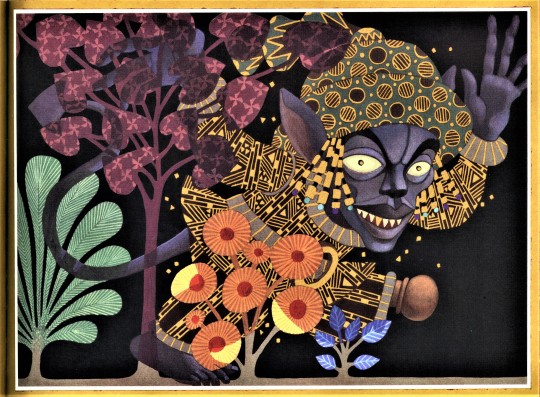

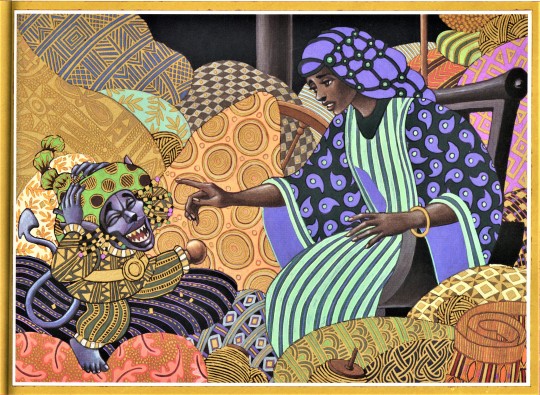


Staff Pick of the Week
My name is Elizabeth Voorhorst, and I am a new writing intern for Special Collections this semester. It is a pleasure to share this space, as I am excited to delve into the vast sea of books that Special Collections makes a home for.
I am an English major, with a focus on creative writing. Because of this, my time spent in Special Collections will be focused predominantly on fairy tales and folklore, perhaps dipping into mythology when curiosity and inspiration strikes hardest.
For this week, I wanted to focus on black creators and their works for Black History Month. Because my pride and passion is folklore and fairy tales, I thought it would be fun to take a look at what we have in our collection and share it with you!
Retellings are always enjoyable, as you get to see the way writers recreate and offer their own flare and heritage to the story. One such story is The Girl Who Spun Gold, a retelling of the German classic fairy tale Rumpelstiltskin. This retelling was written by Virginia Hamilton (1932-2002) and illustrated by Leo Dillon (1933-2012) and Diane Dillon (1933- ).The book was published 1n 2000 by Blue Sky Press, an imprint of Scholastic Inc.
The story is about a West Indian girl named Quashiba, whose mother lies to Big King that she is able to spin golden thread. The King takes Quashiba as his queen, expecting her to fill whole rooms with golden fabrics and finery, which of course she would be unable to do. However, she meets a creature who offers to help, but demands that in three days she must guess his name correctly or be bound to him forever.
Quashiba is now able to fulfill the King’s continuous demands, but is unable to guess the name of her helper, until the King reveals to her that he ran across a strange creature in the woods who was dancing and singing a song that included his name, Lit’mahn Bittyun. So, on the final night, after the room is filled with fabrics and wondrous goods, Quashiba plays dumb for the first two guesses, and on the last guess she gives him his full name and he explodes into a confetti of golden specks. The King repents his greed, but only after three years and a day does Quashiba reconcile with him.
The absolutely stunning illustrations for The Girl Who Spun Gold were made using a four-color process with gold as a fifth color. The Dillons comment on the painting process, stating:
Knowing the difficulty of painting with metallic paint as well as the difficulty of reproducing gold, we still chose to use it, for the story itself revolved around the concept of gold. The art was done with acrylic paint on acetate, over-painted with gold paint. The gold borders were created using gold leaf.
The book was printed on one-hundred-pound Nymolla Matte paper, and each illustration was spot-varnished. Color separations were made by Digicon Imaging Inc., Buffalo, New York, and the book was printed and bound by Tien Wah Press, Singapore, with production supervision by Angela Biola and Alison Forner. Along with Leo & Diane Dillon, the book was also designed with help from Kathleen Westray.
View more work by African American artists.
View more posts concerning African Americans.
View more Staff Picks.
- Elizabeth V., Special Collections Undergraduate Writing Intern
#Staff Pick of the Week#black history month#virginia hamilton#fairy tales#Leo Dillon#Diane Dillon#the girl who spun gold#rumplestiltskin#folk tale#black writers#African American writers#African American artists#scholastic#black artists#Blue Sky Press#children's books#Historical Curriculum Collection#illustrated books#Elizabeth V.
224 notes
·
View notes
Text
My Version of Bulgarian Treasure Planet — “The Third Epoch”
This is subject to a lot of future changes, so reblogs are discouraged because the reblog would soon be outdated.
The year is 2580. The Earth is a concrete husk of what it used to be; all life which used to reside here is now completely extinct. It's only inhabitants left include humans and robots. Many humans and robots on Earth are space cadets who work for corporations. Their purposes as space cadets are to venture outward into space in their spaceships in search of more materials, like coal or oil, having used up all of Earth's. The story focuses on two spaceships in particular: the Hispaniola and its crew of space cadets, and the Pensiero and its crew of space pirates.
The crew of the Hispaniola works for KOSHUM, a government operation led by NASA that targets space pirates and other groups that get in the way of normal operations within corporations. KOSHUM has the Hispaniola prevent mainly the crew of the Pensiero from plundering neighboring spaceships. The Pensiero relentlessly invades other spaceships in search for a particular material, although the crew of the Hispaniola is not certain of what it is. They presume these pirates search for gold or some other valuables, as most other pirates.
The crew of the Hispaniola includes:
Captain Smollett

Captain Smollett is a 42 year old space cadet and captain of the Hispaniola. Smollett graduated from the Bulgaria Space Academy, and the husband of Elena. He is prideful of his home country Bulgaria and has dreamed of serving it since he was a teen. Smollett is quite intelligent and outgoing, and cares deeply for every member of his crew, especially Filip, but is also clumsy. He often spends his freetime watching American football, cooking oddly professional-level meals for his crew, or solving crossword puzzles.
Cabin Boy Filip

Filip is the 38 year old, Indian-Bulgarian Cabin Boy of Captain Smollett. He and Smollett were roommates back at the Bulgaria Space Academy upon random selection and grew a tight bond since they've met. Filip attended the Bulgaria Space Academy because he felt like he needed some sort of purpose in life, by which this need had then been fulfilled. He has a strong faith and passion for science, and is thoughtful, determined, and kind-hearted, but is also deeply insecure of himself, withholding much about himself from most people, except for his girlfriend SV. His hobbies include watching science documentaries, learning heavily about random niche topics that pique his interest, and drawing.
Cabin Girl SV (@poni-poki self insert)

SV is a 23 year old American-Bulgarian Cabin Girl of the Hispaniola. Finding herself passionate for Bulgarian culture, she went to study abroad at New Bulgarian University. There, SV met Filip, and after some time, came super close to dating him, but Filip couldn’t let it happen, because he knew he’d be extremely busy at his future school, the Bulgaria Space Academy, training as a future space cadet. She loved Bulgaria still, though, and decided to permanently move there. After she had graduated college, she began job hunting, eventually applying for a data entry job at KOSHUM. To their bewilderment, SV and Filip ran into each other shortly. Filip, ecstatic, decided to begin dating her, knowing they’d now always be near each other. SV, being an overachiever, ranked upwards quickly, becoming a space cadet in no less than three years. SV now is a proud member of the Hispaniola. She is shy, gentle, and passionate, but greatly nervewracked as well. SV enjoys drawing, studying linguistics, and collecting obscure old media.
Computer Technician Anka

Anka is a 21 year old computer technician. She has been involved in NASA for her entire life. Other than that, her origin is unknown. Anka rarely speaks to others unless necessary for spaceship operations, and is very quiet and unexpressive, and sometimes even comes off as unfeeling to most people, although it isn't true. When she isn't on duty, she remains in her room, away from others. Anka is massively dedicated to her duties, and would even die for NASA if necessary.
The crew of the Pensiero includes:
Captain Flint

Captain Flint is a 64 year old Czechoslovakian-Bulgarian space pirate, formerly a space cadet, and is the Captain of the Pensiero. He barely made it by in the Bulgaria Space Academy, his grades averaging a C+. Nevertheless, he is widely knowledgeable about space tech, and is prideful as captain of the Pensiero, naming his ship after his favorite song, “Va, Pensiero” by Giuseppe Verdi. He became a pirate in rebellion against KOSHUM, opposing their colonizing ideals and stealing the Pensiero for his own use. Flint as a pirate has a great plan against Koshum, particularly a weapon. This weapon is a top secret project that he and Dzhon Silver have collaborated on since they graduated Bulgaria Space Academy. It has great power over all else; harnessing its power is the reason he lost his left eye at one point. Flint is intelligent, charming, and humorous, yet impulsive and reckless. Although it may not seem like it, he cares plenty for his crew, and always wants to keep them safe. Flint in his spare time enjoys listening to opera, playing cards with his crew, and having sex.
First Mate Dzhon S. Silver

Dzhon Super Silver is a 65 year old German-Bulgarian space pirate, formerly a space cadet, and is First Mate of the Pensiero. He and Flint have bonded greatly with each other in the past, even having dated each other. The two broke up eventually over a private dispute over the top secret project they had collaborated on. Nonetheless, he still works with Flint, having made peace with each other, despite still being exes. This project was actually the reason he lost his left leg, similarly to why Flint lost his left eye. Dzhon is charismatic and determined, yet also spiteful and nihilistic. Other than working with Flint, Dzhon is particular about preserving his life. Gradually his body has been becoming more and more artificial, enough to enable him to outlive most others. This obsession of his has consumed him, and often when he has free time, he is working on constructing his spare parts, being a former robot technician. Dzhon does give himself breaks though, and enjoys playing cards with Flint, or tasting his fine rum collection.
Computer Technician Black Dog
Black Dog is a 65 year old Bulgarian robot space pirate, formerly a space cadet. He began working for Flint after secretly escaping KOSHUM and hearing about his rebellion. Black Dog doesn't enjoy calling himself a pirate, but agrees with Flint's values over NASA's. He is a humble man who may come off as intimidating, due to his quiet demeanor and staggering 7 ft height, but he in actuality is quite gentle and careful. Black Dog has a lot of appreciation for the small things in life; he is protective of those who treat him more kindly than most. Black Dog can also be stern, but only when necessary. He enjoys reading and likes a good black coffee, particularly with two sugars.
Computer Technician Billy Bones
Billy Bones is a 67 year old Bulgarian robot space pirate, formerly a space cadet. He had only joined Flint's crew solely because Black Dog joined; he and Black Dog used to be in a relationship together. Black Dog is at peace with it, but Billy still bickers with him over it. Billy is sharp and sarcastic, and always has something to say.
Computer Technicians Pew, Ben, and Israel
These three triplets Pew, Ben, and Israel are all 20 year old Bulgarian robot space pirates. They were originally employed by Dzhon to assist him with his assignments, whether that be repairing a robot, or repairing the ship. They get into a lot of trouble though, and often slack off or mess around, drunk on Dzhon's rum.
Computer Technician Syz (my self insert)

Syz is a 19 year old American-Bulgarian space pirate. She, like her fellow technicians aboard the Pensiero, is a robot. Syz joined the Pensiero unintentionally; Flint and his crew had burglarized a ship with dysfunctional robots as its cargo, ready to be destroyed, in search of spare parts for an injured crewmate. They found Syz’s body in near perfect condition, and decided to steal it as well. They rebooted her, and from there she decided to join the crew. Syz is very quiet, private, artistic, and internally nihilistic, although she isn’t rude. She hates people generally, and has ever since she was nearly thrown away, only seriously trusting Black Dog and Captain Flint. Syz enjoys painting, listening to classical music, and writing.
Due to the fact that the Pensiero's crew is larger than the Hispaniola's crew, the Pensiero is a much larger ship.
#btp#the third epoch#bulgarian treasure planet#treasure planet 1982#planetata na sukrovishtata#bulgaria#treasure planet#the treasure planet#sydneys art
9 notes
·
View notes
Note
🌸 Tell me about your OC(s) - with pictures if you want !Pick some facts you want to share about them & let us gush about them together! Then send to other creators to do the same ✨
Hey Vivi! I'll talk about my task force, this time!
Task Force Shatrujeet 💀🗡️

Col. Shaurya Kulshrestha
Shaurya found the task force named "Shatrujeet", which in translation means "winning against the enemy". The ideology of making this task force was to collect a group of commandos who have the full potential, ability and capability to deal with complex special operations, and protect the country from foreign threats.
The Colonel was Arjun's guide and mentor throughout his journey, before the responsibility of leading the task force landed on the Captain, making Shaurya confident that now he's independent and knows what to do.
Shaurya is part of the Mavericks, a secret division of the Indian Army, where elite soldiers are interlinked with the intelligence agencies.
The Colonel never actually mentioned if he was married or not. Some say that he never did, and some say he was divorced under some conditions. But, it's never proven, nor confirmed.
The Colonel had an old contact with General Shepherd, that paved the way for Arjun to join the Task Force 141.

Capt. Arjun K. Dhingra
Arjun has a locket of his wife's picture and keeps it safe in his drawer. It motivates him into believing his wife's presence was always there. He also has Lakshya's fountain pen, the pen he used to write poems in his diary, as a memory.
The Captain has taken part in many crucial special operations, for his accurate strategic planning and leadership. The 9 PARA SF has always considered Arjun more reliable for going on missions, something which also irked the interest of General Shepherd that made him become a part of the 141.
Arjun's nature towards his commandos is kind of mixed. He sometimes shows concern, and kindness, but at the same time he's harsh and fierce. The conclusion can be that he wants the best for his commandos, and wants to train them enough so they're capable of handling any sort of tough obstacles.
Arjun has never tried to smile that much, ever since the tragedy. But thanks to Kavya, and the hope of his commandos, he was able to regain that happiness that was lost in his life back.
Arjun knows most regional languages, since the commandos are also trained to learn these languages for covert operations, respectively. He surprised Aditya one time.. by speaking fluent Gujarati.

Lt. Aditya Tripathi
Aditya had shown to be a comforting presence among everybody, something which also enlightens others from their hard times.
Aditya is also a part-medic! He used to pursue medical studies to become a doctor like his mother, but under such circumstances, it made him join the special forces, and used that very knowledge to treat the wounded.
Aditya makes others happy and especially himself. Because in hard times, he suffers a little when he's not able to save a wounded person's life.

Lt. Yuvraj Chaudhary
Yuvraj is respectful and generous to everyone, especially women. In his belief, he considers women as "devi" or goddess in translation, and wishes if more women joined the army.
Yuvraj met Aditya during the NDA, and even graduated in the IMA with him together. They've been very close to each other like brothers.
Yuvraj has a signature mark, rolling his moustache when he feels pride within himself, or if anything went successful. More like, saying "flawless".
Yuvraj is a Rajasthani, and he knows the Marwadi language. At times he mocks Aditya by saying something in his regional language, much to Tripathi's disappointment.
Capt. Venkateshwar Subramanian
(still need to find the faceclaim!)
Venkateshwar graduated from the OTA, as an computer engineer, joining the PARA SF and becoming a part of Task Force Shatrujeet.
Venkatesh has shown a lot of interest in technology since he was a young child, and always excelled in the field of computers, that made him a special programmer in the team.
Venkateshwar has close contact with Alyssa Martinez (@alypink), who is also a programmer in the Mexican Special Forces, and they are known to have worked together in a joint operation.
#thanks for the ask!#cloudofbutterflies92#oc asks#call of duty oc#indian oc#task force shatrujeet#colonel shaurya#captain arjun#lieutenant aditya#lieutenant yuvraj#captain venkateshwar
19 notes
·
View notes